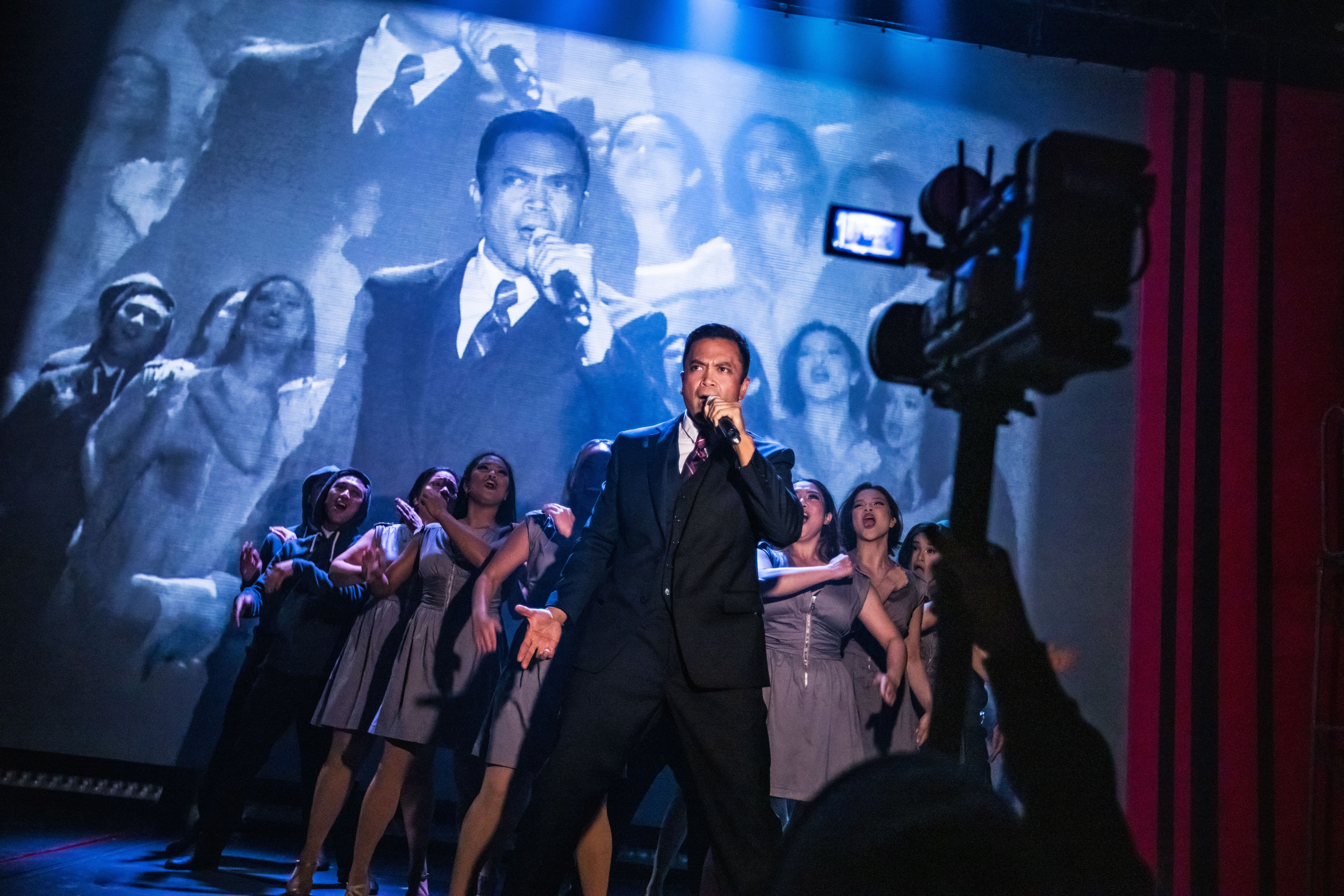NEW YORK CITY — Understanding the historical significance of a nation that is over 8,000 miles away is difficult for many people. But when the nuances of a different culture, foreign political turmoil, and love and loyalty are included in a play about that country, it is no wonder that Here Lies Love (now playing for only a few more weeks at the Broadway Theatre) was difficult for audiences and critics in New York City to understand. A collaborative effort written by David Byrne and FatBoy Slim, the show follows the life of former first lady of the Philippines, Imelda Marcos, from her somewhat humble beginnings, to the rise to power of her husband, to the fall and eventual forced exodus of her family.

Mostly known throughout the world for her extravagant lifestyle and many shoes, Imelda (played by Arielle Jacobs) rose in power and prestige with her husband Ferdinand (played by Jose Llana) over several decades and then lost that power and were exiled from their country after a political uprising in 1986. The main political rival, Ninoy Aquino (played by Conrad Ricamora), was a national hero and martyr in the Philippines, which is portrayed in the show and made aware to anyone arriving in Manila at the Ninoy Aquino International Airport.
Here Lies Love is completely different than what the traditional audience expects from a Broadway show. There has been a lot of gate-keeping that I have noticed within the world of criticism and theatre fandom about what does or does not constitute “Broadway-level” or “Broadway-worthy theatre.” For example, the popular show Six (coming to Utah in January) has had its fair share of haters because of the length of the show and lack of traditional plot structure. Similarly, Here Lies Love is a shorter show without an intermission, and the producers and creative team have really thought outside of the box by turning the theatre stage at the Broadway into a disco stage and allowing much of the audience to stand and experience the show in an immersive environment.

Some knowledge of the culture of the Philippines comes in handy when looking at how this show has taken form on Broadway. There has been a great deal of buzz about this being the very first Broadway show with a full Filipino cast. Filipino stars are no stranger to the Great White Way, including stars like Lea Salonga and Eva Noblezada. However, they are often tasked with portraying any Asian ethnicity or any truly any minority. (Both actresses famously starred in Miss Saigon while not being Vietnamese). The creators of Here Lies Love have made an effort to have the cast accurately reflect the Filipino story they are telling.
Also, the intriguing and interactive set design, by David Korins, is unlike anything I have ever seen at a concert or stage event. It initially reminded me of the Great Comet, but then there were elements of movement and audience inclusion that can only be experienced, not explained.

Why does this matter? I am a white woman who walked into a space to see Filipino actors tell a very complicated and controversial story from their heritage, entirely represented by actual Filipinos. And as I got into the car to head to the airport for this trip, my 17-year-old daughter, who is a half-Filipina aspiring actress/costume designer, yelled to me, “Nanay!” which means “Mom” in Tagalog, “Make sure you look at it from Filipina perspective before you decide if it is good or not!” This is a very tall task. I have been to the Philippines a few times, and was married to a Filipino man for a time, and have the daunting task of helping my two mixed race daughters navigate the world balancing two cultures, one of which is overrepresented and one of which is underrepresented. So to have the opportunity to see a show, fantastic or flawed, that provides representation, can mean the world to a Filipina Broadway lover.
My daughter would have been pleased to see some of the fantastic surface level Filipino representation. From the beginning comment by DJ Moses Villarama about Filipinos being the inventors of Karaoke (a Filipino party does not really begin until the karaoke machine comes out), to the perfectly represented traditional Filipino dresses and dress shirts by costumer Clint Ramos, to the intensely accurate love of beauty pageants, I felt like I was right back at a party with my in-laws.

I had concerns about whether the creators, who are not Filipino, could truly understand the difficulties of the Marcos regime and the political divisions among people in the Philippines while living under Marcos. After all, one of the children of Marcos is the current president of the Philippines (which I was pleased was mentioned near the end of the show), and when one takes the time to discuss life under Marcos, it is not as clear-cut story of an evil dictator engaging in wasteful spending. So, I was pleased to discover that the storytelling in Here Lies Love did portray this part of the history well. The song “Order 1081,” which was sung by the entire ensemble near the end of the play, to be very haunting and moving. Peter Nigrini, as projection designer, has developed projections that include many images from actual historical images from this period of martial law, mixed with images of the onstage action from different angles. This technique made the song, and the entire production, a fascinating work of historical perspectives. Another impactful — and culturally relevant moment — was the final song, “God Draws Straight,” which uses actual words from the People Power Revolution that removed Marcos. The amazing musicality of the cast at that moment under the musical direction of J. Oconer Navarro, with the revealing of a gorgeous mural on the back wall of the Broadway Theatre, was inspiring.
Here Lies Love was not perfect. I benefit from a vast knowledge of the Philippines, and so I understood and felt moved by the story. But I can see why others would not. It was extremely fast-paced, which I found exciting, but could see why people might struggle. And many of the songs were fun in the moment, but I am struggling to remember them as I type this review. Nonetheless, it is an absolute shame that Here Lies Love is closing in two weeks. There are many shows with more flaws that last longer on Broadway. It is tragic that the new and innovative production struggles to find its footing on Broadway, an environment which seems rewards star power and conventionality and not experimentation and groundbreaking creativity.

As an out of town critic, my mind goes to regions and places outside of New York where Here Lies Love could have a second life. I could see this show succeeding in Las Vegas, where shorter shows and spectacle thrive. After all, my children have asked to drive the almost seven hours just to get to a popular Filipino restaurant for fried chicken, and I can imagine that based in Las Vegas, that Here Lies Love could be a draw for members of its target audience living all over the West. Then again, Here Lies Love deserves an audience of adventurous theatre-goers, whether they have connections to the Philippines or not.
[box]The Broadway production of Here Lies Love plays at various times through November 26, 2023, at the Broadway Theatre (1681 Broadway New York City). Ticket prices vary. For more information, visit herelieslovebroadway.com.[/box]
